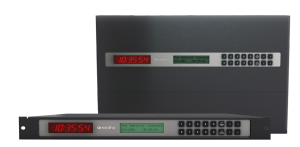Sync Options for Master Clocks
Have you ever visited a facility, looked up at the clocks and taken note that every clock you see displays the exact same time? Chances are you haven’t! While accurate time is somewhat hard to notice for the visitors of a particular building, it is a very important aspect for the employees of many hospitals, schools, manufacturing plants, and tons of other institutions that need to adhere to strict schedules. However, the accuracy of the clocks in these facilities isn’t maintained by the janitorial or maintenance services constantly correcting the time on each individual clock day-in and day-out. The accurate time is actually made possible by a master clock. The job of the master clock is to distribute its accurate time to all the other clocks in the building that are connected to the system. So wherever the master clock is receiving its time, all wall clocks should inevitably be receiving the same time.
Now that we’ve explained how the master clock provides the time for the wall clocks, we must explain where the master clock gets its time! There are generally three ways the master clock receives accurate time for distribution to all other clocks: through an NTP server, GPS receiver, or an internal real-time clock. The remainder of this article will go over these three ways to synchronize, so when it’s time for you to choose a master clock, you’ll know which method best fits your application.
1. NTP Server
Synchronization from an NTP server can go one of two ways: facilities can either choose to access an external NTP server over the internet for the accurate time, or they can go the extra mile and purchase an internal NTP server for their building. Most will choose the former, given its ease of implementation as well as its low cost. With the external NTP server, the user need only hook their master clock up to their Ethernet network and input a URL from the NTP server they desire. After that, the master clock will synchronize to that server’s time. With the internal NTP server, it’s a little different. In this case, the actual server will usually be installed within the building, and use the internet to receive the time, or reference GPS time through a GPS receiver. The main purpose of the internal NTP server is that many other devices, other than just the clocks in the facility, can be synchronized to that NTP server—providing synchronized time for all devices connected to the facility’s network.
2. GPS Receiver
GPS time synchronization is the more accurate, as well as secure, way for the master clock to receive its time. While NTP time is extremely accurate, GPS time has been known to be a more accurate form of time synchronization. With GPS, the receiver attached to the master clock sends its exact location to satellites that are orbiting the earth. The satellite recognizes the location of the receiver and delivers pin-pointed accuracy of the exact time in that location. The GPS receiver then relays the accurate time to the master clock, which distributes it out to all of the wall clocks in the building. The GPS is more secure than NTP because the facility does not have to breach the firewall and use the internet for a time source.
3. Real-time Clock
The real-time clock is an option for master clock synchronization when the user does not want or need go outside of their building for accurate time (something GPS and NTP time cannot do). While the real-time clock is a great, cost-effective option, it is the least accurate out of all the aforementioned methods of master clock synchronization. However, some facilities don’t require such an accurate time source. Additionally, some master clocks have better real-time clocks than others, which is why in a lot cases, the real-time synchronization can be a viable option. The real-time is kept inside the master clock, generally through a crystal oscillator. The real-time clock retains the time and the oscillator keeps it stable to the best of its ability, providing a constant time source for the master clock and all wall clocks in the system. Some oscillators can even stay +/- 2 minutes to the accurate time per year.
Now that the three most common methods of synchronization for a master clock have been explained, you can make the choice. In the grand scheme of things, neither method is better than the other. When the timing needs of a facility must be fulfilled through the use of synchronized time, the method used to deliver the time to the master clock and all subsequent clocks thereafter will be chosen depending on the given situation. In some cases, the facility will require synchronization that does not use the internet for security reasons, but still needs extremely accurate time—making a GPS or real-time clock application the best choice. Sometimes, facilities aren’t as concerned with security issues and using an external NTP server over the internet is the best option due to its cost effective, yet reliable nature. When it’s time for you to make the choice, evaluate your situation as thoroughly as possible in order to make the right decision for synchronizing your master clock.

